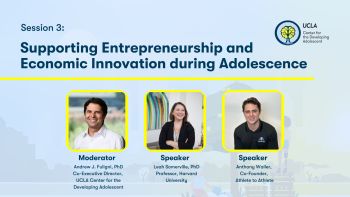Written by Megan Rouse, Communications Associate, UCLA Center for the Developing Adolescent
This blog post was written using interviews from part 1 and part 2 of the new Adaptivity Podcast episode, “Social Media and Adolescents.” In these episodes, host Ron Dahl interviews undergraduate students and members of the Youth National Scientific Council on Adolescence, Becker Chabaan and Dallas Tanner, as well as researchers, Jacqueline Nesi, associate professor at Brown University, and Nick Allen, the director of the Center for Digital Mental Health at the University of Oregon, about the complex and controversial topic of social media use during adolescence.
Listen to Part 1 on iTunes, Spotify, or Libsyn. Listen to Part 2 on iTunes, Spotify, or Libsyn.
Framing the Discussion
All young people need access to tools that help them explore the world and learn the skills needed to become thriving adults. Digital technology, and specifically social media, is a tool that many young people use in their daily lives to form connections, acquire knowledge, and navigate complex systems.
Social media has clear benefits and risks for all users, but public discussions of social media use during adolescence often skew negatively, framing the effects of social media on adolescents as a crisis and an insurmountable problem. This framing, called ‘crisis framing’, leaves out the potential benefits of social media on adolescents and steers people away from finding solutions to the real harms associated with it.
Nick Allen, the director of the Center for Digital Mental Health at the University of Oregon, offers a more constructive way to approach this complex issue.
Allen explains that ‘crisis framing’ is not novel. In fact, history reminds us that society consistently fears new things introduced to younger generations, from rock music to the radio to the printing press being the ‘crisis’ of their era.
“If you look at history, you will see a similar cycle of panic,” says Allen, “This is as old as Socrates.”
Instead of defaulting to crisis framing, Allen offers two principles to consider when examining digital technology use among young people.
“The first principle I would apply is that all technology has risks and benefits,” says Allen.
The benefits of social media can come from young people fulfilling key developmental needs, a set of science-based needs during adolescence that research suggests can lead to healthy development and future wellbeing. These needs include things like exploring the world, developing identity and values, and connecting with others. Young people can fill these needs by using digital technology as a social and academic tool, and many already do.
A Pew Research Teens and Tech survey reported that 81 percent of teens who use social media feel more connected to their peers, and 69 percent say social media helps them interact with more diverse groups of people, helping them learn about the world and develop new knowledge and perspectives.
“It’s a necessary thing to learn because, at one point in everybody’s life, you’re going to face social media, even if it’s not social media, just social interactions online, period,” says Becker Chabaan, an undergraduate at UCSB and former Youth Scientific Council on Adolescence member. “Everybody’s online and we’re not going to go back to pen and paper.”
The second principle that Allen encourages us to consider is that young people have participatory rights, which refer to the rights of individuals to take part in decision-making processes that affect themselves and their communities. Taking away the rights of young people to participate in digital technology and social media could deprive them of opportunities to meet key needs and to learn with new technology, which could be essential to their future careers and the ways in which they navigate the world.
Young people, Allen explains, “have the right to participate in things that are important to them, their development, and their future.”
“Our phones, if used correctly, can be quite helpful in our learning,” Dallas Tanner, an undergraduate at UCLA and former Youth Scientific Council on Adolescence member, offers.
Designing Digital Technology For Young People
We know from developmental science that social media is not all good or all bad. Although there are real benefits that can come from these online spaces, there are real risks that should be mitigated.
Suggested approaches to balancing these benefits and harms range from educating youth about how social media works to keep their attention to in-school or all-out bans on technology. Some researchers warn that regulations may be too broad and possibly premature, while others suggest more precautions should be taken.
However, when you look closely, it is easy to find common ground in this broad debate. One thing most people can agree, from researchers to parents to young people, is that social media platforms should be designed for adolescents in a way that limits potential harm and promotes benefits. A survey found that nearly 80 percent of parents believe technology companies have a responsibility to protect children from inappropriate content.
“What we know from the science is that kids are impacted so differently by these technologies, and there are so many different ways that they’re using them,” says Jacqueline Nesi, an assistant professor at Brown University.
What Nesi suggests is creating platforms that are informed by developmental science and that are customizable by parents and young people so that individual needs can be addressed.
According to the National Sleep Foundation, eight out of ten teens do not get enough sleep. Modifying social media by limiting screen time in the evening or providing facts about the need for sleep during adolescence could be a way platforms are designed to better address the fundamental needs of adolescent wellbeing.
Another suggestion could be excluding quantifiable interactions, like likes, to encourage deeper connections online and limit feelings of self-doubt and isolation. In 2018, 37 percent of teens reported feeling pressure to post content that would get more likes instead of content they really wanted to share.
“I think that there are a lot of cases where not having those quantified metrics would probably make a big difference,” said Nesi.
Research, developmental science, and the needs of adolescents and parents should be evaluated when making these platform modifications.
Young people agree that digital technology should better protect their safely and wellbeing and many think technology companies should be responsible for this. Twenty percent of teens feel extremely or very concerned about their data being collected by these companies. Being able to customize social media experiences could allow young people to exercise agency and cultivate online spaces that build healthier habits and make them feel safer.
“I think that it probably requires a pretty significant redesign and maybe a different business model as well,” Nesi admits.
The good news is researchers, as well as young people, are ready and willing to help companies tackle these concerns.
“We’re here to help you and support you and inform you,” says Allen in regards to tech companies, “If we can work with some of these large companies to move their products towards better safety, better design, you’re really playing the main game, then.”
Key Takeaways
- Making digital technology safer, healthier, and more beneficial to young people while minimizing its risks requires an institutional approach that needs the collaboration of researchers, developers, clinicians, technology companies, and young people.
- We know enough about brain and social development in adolescence to identify the areas where social media regulation could have a positive impact; but, restrictions that are too broad or that frame the problem as a crisis could limit benefits and cause additional harm.
- Companies and platforms should redesign their platforms with the developmental needs and developmental science of adolescence in mind. There is no one-size-fits-all approach and platforms should be customizable to meet each individual’s unique needs.
- Finally, young people should be involved in helping to create digital technology that benefits themselves and their futures. Many young people already have ideas on how this can be implemented and their ideas should be heard and supported via youth councils, advisory boards, beta testing, surveys, etc.
Find additional resources about social media and adolescents from our network:



